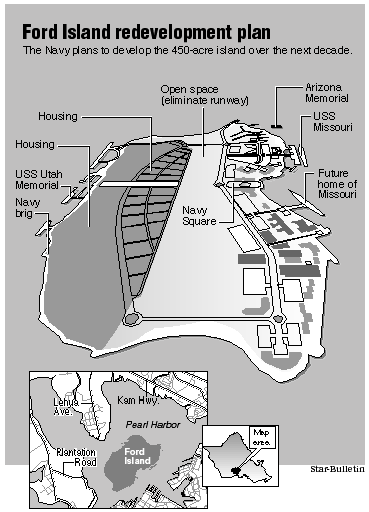

By Craig T. Kojima, Star-Bulletin
The north side of Ford Island will become the site of
a major housing development. Before it does, the Navy's
brig will have to be moved. The 120-bed facility
opened in 1991.
Arresting times
ahead for
Ford Island
A development plan means
By Gregg K. Kakesako
the relocation of several facilities,
including the 7-year-old brig
Star-BulletinProgress has finally caught up with the once isolated Navy community on Ford Island. An ambitious development plan for the new millenium will mean the relocation of several current occupants and facilities, including the 7-year-old brig.
When the Navy opened the 120-bed prison facility in 1991 on the 450-acre island in the middle of Pearl Harbor, there was no tourist attraction planned on the scale of the battleship USS Missouri.
There were only a few homes and Navy barracks, and access was dependent upon a ferry.
"There was an awful lot of space," said Jim Taylor, program coordinator at the brig for the past 81/2 years. "I think it was built here because it is an island and because there was so much land and space available."
But all that has changed, and the Navy now projects that the population of Ford Island -- 3,000 -- will more than double in the next decade.

With the "Mighty Mo" slated to lower its gangplank to the public in January, the Navy is applying for special congressional legislation to allow private developers to join in a proposed $600 million operation with housing, commercial retail shops, restaurants and a museum. Beginning in the year 2000, the Navy wants to build 500 to 600 family units and another complex for 1,000 unmarried enlisted sailors.The plan is helped by a mile-long floating concrete bridge that now connects the island with the Pearl Harbor mainland.
"The housing project wasn't a gleam in anyone's eyes back then," Taylor said.
With the encroachment of civilization, the Ford Island master plan envisions moving the brig and converting the building into "a community support activity," says Navy planner Stan Yuen. That could be a recreation center or a child care center.
But any conversion will probably take place in the last phase of the Navy's plan, which is projected to take more than a decade to complete. The north side of Ford Island, where the brig is located, will be the site of a major housing development.
Funding for the $8.6 million air-conditioned facility was approved in 1989. There are separate cells for 15 men and another five cells for women. The rest of the prisoners are housed in two dormitories, each holding 25 inmates.
The 40,395-square-foot facility is divided between the prison complex and two other dormitories that make up the correctional custody unit, capable of holding 50 short-term offenders whose behavior the Navy hopes to correct.
"Normally, the correctional custody unit is the last resort to save an individual and help him adjust to military life," Taylor said.
The intent of the Navy's 30-day correctional custody program, Taylor said, is "to retrain young sailors who are in their first enlistment, but who are unable to adjust to military life."
Custody unit "awardees" are berthed separately from brig prisoners and are separated from them except during Thursday church services. "They are given the basics necessary to survive in the military," Taylor said, "and we also concentrate heavily on the work ethic."
Taylor is proud of the brig's correctional custody program, saying it has the highest success rate in the Navy, with 84 percent of awardees satisfactorily completing their enlistment without further disciplinary problems.
Lt. Cmdr. Hollis Kunimura, the brig's executive officer, said the Ford Island facility holds offenders from all services who are awaiting court-martial or whose sentences are less than 30 days.
It is staffed by 80 Army, Marine Corps, Air Force and Navy personnel and four civilians. And unlike Hawaii's prison system, the naval brig is never overcrowded, averaging an inmate population of 30 to 35 prisoners.
All military prisoners whose terms are longer than five years and any officers convicted of a crime are transferred to Leavenworth.
By Craig T. Kojima, Star-Bulletin
Petty Officer Bowin Mariano mans
the brig's control desk.
Brig duty: ‘Stressful
By Gregg K. Kakesako
... but not that bad’
Star-BulletinPetty Officer Bowin Mariano, an eight-year Navy veteran who was raised in Hawaii, said his current assignment at the Ford Island Naval Brig may steer him to a career in law enforcement.
"It's a bit stressful," acknowledges Mariano, who by training is a supply clerk, "but it's not that bad."
Although the Navy supplies more than 80 percent of the guards and cooks at the brig, corrections is not a career field.
It is, though, in the Army, and Staff Sgt. Al Cappel -- who has spent 16 years in corrections -- plans a career in law enforcement when he retires from the service in four years.
"I love what I do," said Cappel, whose dad also was a corrections official in the Army.
After a tour at Fort Leavenworth in Kansas, home of the military's major prison, Cappel finds the job at the Ford Island brig much easier. "There's a different caliber of prisoner here," said Cappel, 35. "We're not dealing with hardened criminals."